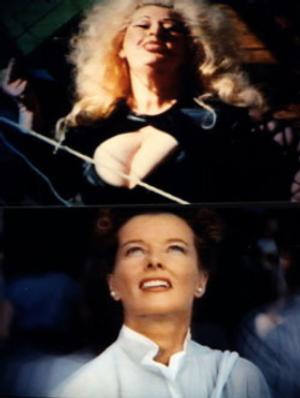John Waters
dal 6/2/2004 al 15/4/2004
Segnalato da
6/2/2004
John Waters
New Museum, New York
Change Of Life. The iconoclastic filmmaker whose cult classics such as Mondo Trasho, Pink Flamingos, and Hairspray defined ''trash'' for a generation, turned to still photography in the early 1990s. Selecting from the many photographic images he took, Waters assembled photographic sequences to create his own 'little movies.' The first comprehensive exhibition of his photographic works made over the past decade, showcasing 75 of these works

Change Of Life
John Waters, the iconoclastic filmmaker whose cult classics such as Mondo Trasho, Pink Flamingos, and Hairspray defined ''trash'' for a generation, turned to still photography in the early 1990s. Watching videotapes of the films that fascinate him (from Cleopatra to Baby Doll to The Bad Seed), Waters photographed images off the television screen, capturing moments that became the raw material for his new artworks. Selecting from the many photographic images he took, Waters assembled photographic sequences to create his own ''little movies.'' The New Museum presents the first comprehensive exhibition of John Waters' photographic works made over the past decade, showcasing 75 of these works. Selected objects, scrapbooks, artifacts, movie props, and ephemera that Waters collected from the late 1960s through the early 1970s will also be on view in a specially-created Waters environment, designed by his longtime set designer Vince Peranio, highlighting Waters' ongoing fascination with photographic imagery and the mass media. The exhibition also features the first public showing of Waters' extraordinary early no budget films: Hag in a Black Leather Jacket (1964), Roman Candles (1966), and Eat Your Make-up (1968).
Over four decades, the controversial and celebrated film director John Waters-once crowned ''The Pope of Trash'' by William Burroughs and more recently hailed as the original voice behind Broadway's smash-hit musical Hairspray-has tested the boundaries that separate the margins of culture from the mainstream. Always eager to raise the issues that polite society works so hard to suppress-such as race, religion, sex, and class-Waters aims to liberate us from the binds of social norms and restrictions. To that end, he has created provocative, hilarious, and important films, and in a more recent change of life, has added photography to his repertoire.
Waters's relationship to photography, like his relationship to mainstream cinema, is defined largely by his outsider status and oblique, but incisive point of view. While many artists strain to attract attention with mammoth photographic prints, Waters works on a small scale, having already seen what the images in his imagination look like projected large. He rejects conventional values of ''good'' photography; there is no fussing over equipment, technique, lighting, or framing. Waters's prints are serviceable. They're also grainy, pixilated, and degraded, having already gone through prior rounds of photographic translation-from film to video, from television to snapshot. And yet, there's an odd beauty about the work. Individual frames-photographed from videotapes that radically condense, crop, and digitize images from wide-screen to fit the squarish format of TV screens-can have an intimate and jewel-like quality about them.
In part, Waters's photographic work is effective and engaging because of its modesty. It refuses to seduce, work overtime, or be precociously hip. It reflects and furthers ideas that have fascinated and preoccupied Waters since he made his earliest films , namely, celebrity, the mass media, voyeurism, religious fanaticism, economic inequities, bodily functions, evil, race relations, family dysfunction, expressions of sexual preference, criminality, and both major and minor lapses in taste. The work is engaging and successful because it is neither doctrinaire nor mean-spirited. Drawing upon techniques of montage, sequential photography, and appropriation, Waters has developed a personal format well suited to his brand of wit, comedy, and commentary.
Comic delivery demands an exquisite sense of timing, and the success of Waters's ''little movies'' hinges on their ability to splice together disparate, borrowed images to make incisive points, play on verbal puns, or clear a path to a visual punch line. Waters knows that comedy is serious, that making fun of what is awful about the world helps to make life more tolerable. He also knows that humor is a useful tool when it's used to demystify the process of making and looking at art. More important, he understands how both art and humor remind us of our shared humanity. To that end, Waters pays homage to narrative genres that best target and exploit our vulnerability: soap operas, horror movies, crime stories, and credulity-straining lurid tabloid tales. For him, and for the rest of us, the real fun begins once we face up to our foibles and step outside our role as passive audience members.
In all his work, Waters presents a remarkably consistent world view and the willingness to imagine what gets unleashed when repressive personal, social, and cultural strictures are lifted. In the photographic and sculptural work, and the early films presented in this exhibition, Waters joyfully exposes cultural contradictions, relentlessly questions ingrained social hierarchies, and cheers us all on toward nonconformity, liberation, and empowerment.
Opening Saturday, February 7, 2004 6:30 - 9PM
New Museum
583 Broadway (between Houston and Prince Streets in SoHo) New York, NY 10012
MUSEUM HOURS
Tuesday - Sunday: noon - 6 pm.
Thursday: noon - 8 pm.
Closed Monday



